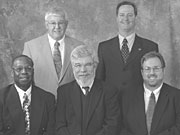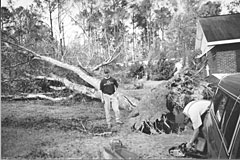 |
Number 73, December 2005 |
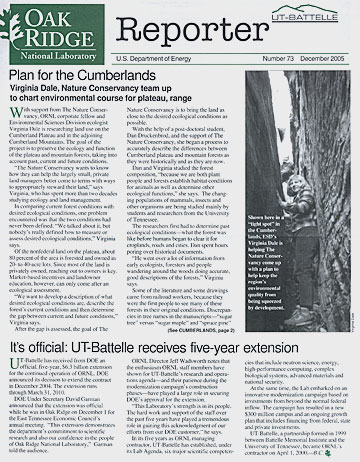 |
|
| Lab Notes | |
|
|
|
|
|
|
Join the club |
|
| Awards Night 2005 | |
| Team UT-Battelle captains lauded for nearly $300K year | |
| New Staff Members | |
| Cardall: Tough Gulf weekend | |
| Letters |
 Plan for the Cumberlands
Plan for the Cumberlands
Virginia Dale, Nature Conservancy team up to chart environmental course for plateau, range
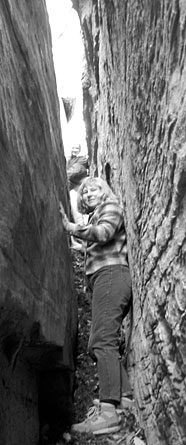 |
| Shown here in a “tight spot” in the Cumberlands, ESD’s Virginia Dale is helping The Nature Conservancy come up with a plan to help keep the region’s environmental quality from being squeezed by development. |
With support from The Nature Conservancy, ORNL corporate fellow and Environmental Sciences Division ecologist Virginia Dale is researching land use on the Cumberland Plateau and in the adjoining Cumberland Mountains. The goal of the project is to preserve the ecology and function of the plateau and mountain forests, taking into account past, current and future conditions.
“The Nature Conservancy wants to know how they can help the largely small, private land managers better come to terms with ways to appropriately steward their land,” says Virginia, who has spent more than two decades studying ecology and land management.
In comparing current forest conditions with desired ecological conditions, one problem encountered was that the two conditions had never been defined. “We talked about it, but nobody’s really defined how to measure or assess desired ecological conditions,” Virginia says.
Of the nonfederal land on the plateau, about 80 percent of the area is forested and owned in 20- to 40-acre lots. Since most of the land is privately owned, reaching out to owners is key. Market-based incentives and landowner education, however, can only come after an ecological assessment.
“We want to develop a description of what desired ecological conditions are, describe the forest’s current conditions and then determine the gap between current and future conditions,” Virginia says.
After the gap is assessed, the goal of The Nature Conservancy is to bring the land as close to the desired ecological conditions as possible.
With the help of a post-doctoral student, Dan Druckenbrod, and the support of The Nature Conservancy, she began a process to accurately describe the differences between Cumberland plateau and mountain forests as they were historically and as they are now.
Dan and Virginia studied the forest composition, “because we are both plant people and forests establish habitat conditions for animals as well as determine other ecological functions,” she says. The changing populations of mammals, insects and other organisms are being studied mainly by students and researchers from the University of Tennessee.
The researchers first had to determine past ecological conditions—what the forest was like before humans began to clear it for croplands, roads and cities. Dan spent hours poring over historical documents.
“He went over a lot of information from early ecologists, foresters and people wandering around the woods doing accurate, good descriptions of the forests,” Virginia says.
Some of the literature and some drawings came from railroad workers, because they were the first people to see many of these forests in their original conditions. Discrepancies in tree names in the manuscripts—“sugar tree” versus “sugar maple” and “spruce pine” versus “hemlock”—required some interpretation.
Because most of the land in the study is owned privately, land use in each small area can vary widely, increasing forest diversity and making fragmentation of species habitat a problem.
“That’s important because patch size relates to how animals use it as habitat,” Virginia says, explaining that different animals have different space requirements—a chipmunk has different needs than a deer. The key factor in how any species will fare is the size of contiguous patches of the same type of habitat.
Using a computer program developed by Frank Biasi for The Nature Conservancy in 2003, Dan and Virginia generated a map of current land use that displays each landform type in a different color. Where there are many small patches of differing landform types, it can look as though tiny confetti has been sprinkled over sections of the map. Where larger patches of contiguous forest type exist, the colored sections are larger and more defined. After the landforms and their influences were implemented in a computer code, different scenarios were enacted to generate possible future conditions.
| The key factor in how any species will fare is the size of contiguous patches of the same type of habitat. |
“We came up with a scenario where we transitioned all nonurban and nonwater lands to forest, as an extreme. We know that will never happen, but it provided bounds on potential futures,” Virginia says.
More realistically, she and Dan considered the possible shift of transitional areas—areas that have been cut but which are maturing to other forest types.
“If we run a scenario where we change transitional areas within this forest-landform type, we get an improvement in the number and size of patches,” she says.
Another element of the forest assessment was the comparison of historical tree size and number of trees per hectare with current size and tree density. The Forest Service defines high-quality trees as those being between 198 and 607 years old, whereas the average tree on the Cumberland Plateau is about 63 years old.
“The trees should be older and bigger to support more desired ecological conditions. The current condition is a high number of small trees; what is a better ecological condition is fewer and larger old trees,” Virginia says. “In the structural features is where the ecological system falls apart.”
For example, older, larger trees with larger canopies provide habitat to species of songbirds whose current habitat is threatened by fragmentation.
“The key purpose of this effort was to try and quantify an approach to reach desired ecological conditions and to describe those for this particular area,” Virginia says.
For the next step, transitioning to “decision-maker mode,” The Nature Conservancy must figure out just who the decision makers are and find ways to educate them about the conditions, current and future, of the land.”
“If they want to improve the ecological conditions of their land, they have to think about larger patches, larger trees and fewer trees,” Virginia says. “But it is important to identify who these landowners are, if they’re interested in ecological aspects, and what they want to do with their land. From a socioeconomic perspective it is necessary to consider what’s acceptable to the small, private landowner.”
This past summer a student from Duke University began the process of defining the target group for education about desired future conditions as defined by Virginia’s study.
“We’re trying to identify land owners who are not limited by knowledge and have an open vision,” Virginia says. “By knowing what the desired ecological conditions are, land owners can learn to steward their land to improve the ecological structure, function and composition of the forests of the Cumberlands.” —Eva Millwood ![]()
 It’s official: UT-Battelle receives five-year extension
It’s official: UT-Battelle receives five-year extension
UT-Battelle has received from DOE an
official, five-year, $6.3 billion extension for the continued operation of ORNL. DOE announced its decision to extend the contract in December 2004. The extension runs through March 31, 2010.
DOE Under Secretary David Garman announced that the extension was official while he was in Oak Ridge on December 1 for the East Tennessee Economic Council’s annual meeting. “This extension demonstrates the department’s commitment to scientific research and also our confidence in the people of Oak Ridge National Laboratory,” Garman told the audience.
ORNL Director Jeff Wadsworth notes that the enthusiasm ORNL staff members have shown for UT-Battelle’s research and operations agenda—and their patience during the modernization campaign’s construction phases—have played a large role in securing DOE’s approval for the extension.
“This Laboratory’s strength is in its people. The hard work and support of the staff over the past five years have played a tremendous role in gaining this acknowledgment of our efforts from our DOE customer,” he says.
In its five years as ORNL managing contractor, UT-Battelle has established, under its Lab Agenda, six major scientific competencies that include neutron science, energy, high-performance computing, complex biological systems, advanced materials and national security.
At the same time, the Lab embarked on an innovative modernization campaign based on investments from beyond the normal federal inflow. The campaign has resulted in a new $300 million campus and an ongoing growth plan that includes financing from federal, state and private investments.
UT-Battelle, a partnership formed in 1999 between Battelle Memorial Institute and the University of Tennessee, became ORNL’s contractor on April 1, 2000.—B.C. ![]()
 F&O staff members shed nearly 800 pounds
F&O staff members shed nearly 800 pounds
Slimmer, safer
Thanks to ORNL’s Wellness Program, a
number of Facilities & Operations Directorate employees are going into the holidays leaner and a little richer. A year ago F&O Director Herb Debban and Facilities Management Division Director Jimmy Stone asked Wellness Coordinator Joan Lawson to help them with a program to reduce soft-tissue injuries.
They came up with a wellness award program on the theory that being fitter and leaner might help avoid the all-too-common soft-tissue strains and sprains that plague the work force.
About half of the nearly 500 F&O employees showed up for an initial “body-mass index” (height and weight) assessment. A BMI of 29 or below was considered the target. About 60 percent met that criteria, while the rest scored over 29—some way over. The criteria for a $100 wellness award was to maintain a 29 or less BMI or lose five BMI units; refrain from smoking; and participate in the Tennessee on the Move program, a stretching program or exercise at a fitness center.
About half of those initial respondents returned a year later for their second assessment. Joan says some of the results were downright amazing.
“Sixteen people changed their BMI from over 30 to below 29. Some individual weight losses were 45, 40, 32.4, 31 and 19 pounds. Ninety-eight of the 139 who returned lost weight, and 25 lost between 5 to 10 percent of their body fat,” Joan says.
“Most of the people say they did it by moving around more and cutting back on eating. These aren’t big lifestyle changes,” she says.
In all, nearly 800 pounds were dropped through the program. Roughly half of the original participants are receiving the award. Hopefully, they’ll also be better able to avoid certain on-the-job injuries.
Joan cites studies that show that a smoker racks up an extra $6,000 in lifetime medical costs over a nonsmoker.
“Two people in the program quit smoking. That’s huge,” she says.—B.C. ![]()
 Cornwell: Leave CSI to the experts
Cornwell: Leave CSI to the experts

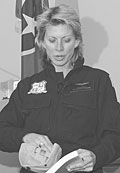 |
| Cornwell peruses a gift copy of the ORNL history for possible clues. |
Best-selling crime author and UT body farm advocate Patricia Cornwell visited the Lab, mostly on business, on November 16, although she did make time for a half-hour talk in Wigner Auditorium before a room full of readers and fans.
Cornwell’s brief remarks before opening a Q&A session centered on decrying the “CSI effect.” It seems that, thanks to the popularity of crime-scene investigation shows on TV, there are now as many arm-chair CSI experts as there are offensive coordinators. It’s doing damage, she says, because the shows are often unrealistic and it is making it harder to convict criminals.
“Detectives are arriving at crime scenes to find that people have already bagged the evidence,” Cornwell says, adding that defense attorneys are also finding success in playing on the lack of realism in the TV shows.
“Juries have all these expectations from TV, and it makes it hard to convict when defense lawyers ask about all these tests that haven’t been performed because they are unnecessary,” she says.
What’s a detective to do?
“Police need to start arresting people for tampering with evidence,” she says. “That would send a message.”
 Supercomputer joins the elite
Supercomputer joins the elite
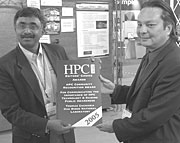 |
|
Thomas Zacharia receives his award from HPCwire publisher Tom Tabor. |
The major players in supercomputing no doubt have their eye on an up-and-comer; namely, us. ORNL cracked the top 10 in the latest Supercomputing Top 500 list, compiled by an international team of computer scientists that includes the University of Tennessee’s Jack Dongarra.
ORNL’s Cray XT3 Jaguar system weighed in at 20.53 teraflop/s (trillion floating operations per second), up from 10 teraflop/s a year ago, to place at number 10 in the list of 500. The Center for Computational Sciences plans to increase the Jaguar’s current 56 cabinets to around 120 in its quest to attain 100 teraflop/s.
The UT, University of Mannheim (Germany) and Lawrence Berkeley National Laboratory group normally issues its rankings at the annual Supercomputing Conference. This year at the conference, Computing and Computational Sciences Associate Lab Director Thomas Zacharia and UT’s Jack Dongarra received HPCwire Magazine awards for “communicating the importance of HPC (high performance computing) Technology and Raising Public Awareness.”
 SNS instruments readying for ’06
SNS instruments readying for ’06
In what Spallation Neutron Source Experimental Facilities Division Director Ian Anderson terms a major milestone for the SNS Instrument Systems, the goniostat for the liquids reflectometer has been successfully installed in the SNS beam line 4B instrument cave.
The work illustrates the level of intense activity and ongoing progress leading toward the project’s completion next year. The liquids reflectometer effort, led by instrument scientist John Ankner, is one of the first three project-funded instruments that must be installed as part of the completion criteria for the SNS project.
Team member Ken Herwig explains that the goniostat—a mechanism capable of more then two dozen precision motions—is the heart of the liquids reflectometer. It has three main sections: an incident arm that defines the neutron beam reaching the sample; a sample stage that positions and orients the sample and an arm that rotates the detector into position to measure the scattered neutrons.
Among the major milestones remaining for the SNS are filling the target module with mercury and commissioning the accumulator ring—Brookhaven National Laboratory’s part of the project—early next year.
 Join the club
Join the club
 |
|
Carolers at the December 1 Club ORNL holiday gathering include (from left) Marilyn McLaughlin, Bonnie Hébert, Leroy Sims, Joe Inger, Sean Ahern, Steven Carter and pianist Beverly Kerr. |
ORNL’s employee organization has been rechristened Club ORNL. Organizers apparently took to heart a Reporter staffer’s comment that the former name, “staff association,” sounded a little, eh, clinical.
Club ORNL kicked off the holidays with an after-work gathering on December 1 featuring food, music and a screening of the Christmas classic, It’s a Wonderful Life. A good crowd made its way over to the Conference Center in the wintry twilight.
After a set of holiday music and just as the sun dipped behind the joint institute across the common, Thomas Zacharia led the group in lighting the decorated tree set up on the center’s second floor.
“I came to the Lab several decades ago as a postdoc and with a very small child. It would have been really nice to have had something like this then,” Thomas told the crowd.
With the mission to enhance the Lab’s ésprit de corps, Club ORNL organizers, led by protocol officer Bonnie Hébert, aim to organize onsite and offsite events to give staff, retirees, guests and subcontractors the opportunity to enjoy each other’s company and get to know each other better through events like the tree lighting and last September’s fall festival.
Other Club ORNL membership benefits will include discount buying privileges, interest groups, excursions, and athletic team support, Bonnie says. Club ORNL activities are under the direction of a 21-member group of representatives from across the Lab. Club ORNL membership is free. Check out the Website at home.ornl.gov/clubornl.
—Reported by Bill Cabage |
 Awards Night 2005
Awards Night 2005
The best of ORNL
ORNL’s outstanding staff members in the areas of research, operations and community service for 2005 were honored on December 9 at the annual Awards Night celebration, this year held at the Knoxville Convention Center. Congratulations to this year’s winners and finalists.
Outstanding Accomplishment in Laboratory Operations
Administrative Support exempt payroll
Winner: Karen Nolan, SNS Project Site Support Office
For outstanding service to ORNL by providing award-winning design and support for the Spallation Neutron Source Projectwise installation and related CAD systems
Finalists: Kathleen Prater Gambrell, Engineering Science and Technology and Brenda Gouldy, Nuclear Science and Technology
Administrative Support nonexempt payroll
Winner: Jaigne Christman, Nuclear Science & Technology
For exceptional coordination of meetings and events with high-level staff, especially for salvaging a crucial international meeting on radiological threat reduction
Finalists: Beth Bailey, Environmental Sciences and Kaye Carter, Condensed Matter Sciences
Bargaining Unit Support by a team
Winner: Steve Davis, Harold Kuziak Jr. and Darrell Watson, Craft Resources
For extraordinary success in replacing the fans in the Building 7920 Vessel Off-Gas System under difficult working conditions, with commendable professionalism, and without contamination incidents or injuries
Environment, Safety, Health, and Quality
Winner: Betty Sueko Evans, Nuclear Science & Technology
For multi-year leadership and personal commitment to the disposition of legacy wastes and to the decontamination and refurbishment of laboratory space
Winner: Charles D. Hochanadel, Judith A. Fitak, Kay Traughber, Health Services
For outstanding service and commitment to the health and safety of ORNL employees, particularly in the areas of injury prevention and recovery
Integrated Safeguards and Security Management
Winner: Allen E. Ekkebus, Deborah W. Barker, Krystee Ervin, Deborah L. Gray, Nancy L. Gray, Jeff Guilford, David Hamrin, Linda L. Horton, Bill Manuel and Karen Moore representing International Services, Laboratory Protection, Legal Directorate, Center for Nanophase Material Sciences, Networking and Computing Technologies, Office of Counterintelligence, Prime Contract
Administration, and SNS Experimental Facilities
For innovative and efficient security solutions in support of programs that have enhanced the security of Laboratory personnel and research efforts while promoting a principal ORNL goal of an open Laboratory campus
Administrative and Operational Leadership at the Group Level
Winner: Ron R. Smith, Laboratory Protection
For exemplary leadership of ORNL’s Security Department, including support of the research mission while efficiently delivering a secure ORNL campus
Winner: Kimberly B. Jeskie, Physical Sciences Directorate
For outstanding mentoring of group staff and personal involvement in ensuring safe and compliant research performance, and for leadership in nuclear facility relocation and reclassification projects in the Chemical Sciences Division
Operations Support by a Team
Winner: Robert T. Jubin, Thomas B. Conley, Ronald A. Crone, Carlo D. Melbihess, Robert F. Peacher, Sharon Robinson and Martin W. Tull representing Environmental Protection and Waste Services, Facilities Development, Nuclear Operations Directorate, Nuclear Science and Technology, and Research Reactors
For developing the vision and providing leadership for nuclear program planning and facilities consolidation to secure ORNL’s future capability to perform nuclear work
Secretarial Support
Winner: Debbie Bain, Engineering Science & Technology
For her strong work ethic, attention to details, comprehensive knowledge of ORNL’s policies and procedures, and tremendous spirit that make her an invaluable member of the Transportation Policy and Planning Group
Finalists: Angie Alford, Nuclear Science & Technology and Sherry D. Samples, Metals & Ceramics
Outstanding Accomplishment in Community Service
Community Leadership
Winner: Maj. Charles Eric Mulkey, Environmental Protection and Waste Services
For repeatedly volunteering for active military assignments to war zones in Afghanistan and Iraq
Exceptional Community Outreach by an individual
Winner: Danny H. Powell, Nuclear Science & Technology
For exceptional community outreach in providing humanitarian efforts at Russian orphanages
Finalists: Eric Manneschmidt, Metals & Ceramics and Bruce Allen Tomkins, Chemical Sciences
Exceptional Community Outreach by a Team
Winner: Cathy Cheverton, Wendell G. Ely, Kahra Gilley, Keith S. Joy, Joan W. Lawson, Roxanne A. Raschke and Nina Jean Roberts representing ESH&Q Directorate, Facilities Management, Logistical Services, Metals and Ceramics, Quality Systems and Services and Safety Services
For a phenomenal team effort in organizing through Team UT-Battelle the largest Komen team for the fifth year in a row for participation in the 8th Annual Knoxville Komen Race for the Cure to benefit breast cancer research and education, raising over $7,000
Esprit de Corps
Winner: Budhendra L. Bhaduri, Computational Sciences & Engineering
For outstanding efforts toward enhancement and enrichment of the lives of our international staff members, while becoming an internationally known spokesperson for the important role of geospatial science in support of national and global missions
Science Communicator
Winner: Lee A. Berry, Fusion Energy
For continued involvement and leadership in education and outreach for plasma science and its applications
Finalists: Stacy C. Davis, Engineering Science and Technology and David J. Wesolowski, Chemical Sciences
Outstanding Accomplishment in Science and Technology
Distinguished Engineer
Winner: Charles W. Forsberg, Nuclear Science & Technology
For sustained and significant contributions in the areas of reactor system concepts, reactor safety, waste management technology, and nuclear fuel disposition
Finalists: Charles L. Britton Jr., Engineering Science & Technology and Charles Stuart Daw, Engineering Science & Technology
Early Career Award for Engineering Accomplishment
Winner: Burak Ozpineci, Engineering Science & Technology
For excellence in engineering research on advanced power electronic device applications and power system topologies that are critical to DOE’s energy efficiency goals
Finalists: Sara A. Pozzi, Nuclear Science & Technology and Todd J. Toops, Engineering Science & Technology
Engineering Development by a Team
Winner: Lawrence F. Allard, Douglas A. Blom, Lynn Degenhardt, John A. Mayo, William H. Sides Jr. representing Condensed Matter Sciences, Facilities Development and Metals & Ceramics
For exceptional collaboration in the conceptualization, plan, design, and supervision of construction of a unique, state-of-the-art, environmentally stable laboratory that ensures optimum operation of advanced electron optical instruments
Inventor of the Year
Winner: Amit Goyal, Metals & Ceramics
For establishing an intellectual property portfolio that has resulted in ORNL’s worldwide dominance in high-temperature superconducting wire fabrication
Finalists: Jack L. Collins, Nuclear Science & Technology and Peter T. A. Reilly, Chemical Sciences
R&D Leadership at the Group Level
Winner: Stephen J. Pennycook, Condensed Matter Sciences
For exhibiting outstanding management skills in building a widely recognized, world-class electron microscopy program, recruiting and mentoring top personnel, and securing substantial increases in DOE funding to support this initiative
Finalists: Robert E. Norris Jr., Metals and Ceramics and Thomas C. Schulthess, Computer Science & Mathematics
R&D Leadership at the Director Level
Winner: Brian A. Worley, Computational Sciences & Engineering
For exemplary vision and leadership in founding the Computational Sciences and Engineering Division and in the growth of its world-class staff and funding, with emphasis on national security and energy assurance and international humanitarian assistance
Finalists: Stanley L. Milora, Fusion Energy and Arvid E. Pasto, Metals & Ceramics
Technical Support
Winner: William H. Sides Jr., Condensed Matter Sciences
For technical excellence beyond the call of duty enabling ORNL microscopy to achieve a world record in resolution
Finalists: Thomas W. Burgess, E. Craig Bradley, Van B. Graves and David L. Conner, Nuclear Science & Technology
John D. Harrell, Craft Resources
Early Career Award for Scientific Accomplishment
Winner: Sergei V. Kalinin, Condensed Matter Sciences
For advances in nanoscale imaging of physical, chemical, and biological properties through the development and application of advanced scanning probe microscopes
Finalists: Radu Custelcean, Chemical Sciences and Z.P. Lu, Metals and Ceramics
Scientific Research
Winner: Ho Nyung Lee, Condensed Matter Sciences
For developing experimental methods and theoretical understanding that led to the discovery of strong polarization enhancement in three-component (Ca, Ba, Sr) Ti03 ferroelectric superlattices grown by pulsed laser deposition
Finalists: A. C. Buchanan III, Phillip F. Britt, Alan Loyd Chaffee, Sheng Dai, Edward W. Hagaman, Michelle K. Kidder, Zongtao Zhang, Chemical Sciences and ORISE
Andrey I. Zheludev, Condensed Matter Sciences
Distinguished Scientist
Winner: Lynn A. Boatner, Condensed Matter Sciences
For pioneering new approaches and techniques for the growth, synthesis, and characterization of novel materials
Finalists: George D. Wignall, Center for Neutron Scattering and Thomas J. Wilbanks, Environmental Science ![]()
 Benefits Summary Annual Report for 2004
Benefits Summary Annual Report for 2004
Summary Annual Report
for
RETIREMENT PROGRAM PLAN FOR
EMPLOYEES OF CERTAIN EMPLOYERS AT
THE U.S.
DEPARTMENT OF ENERGY
FACILITIES AT OAK RIDGE, TENNESSEE
This is a summary of the annual report for the RETIREMENT PROGRAM PLAN FOR EMPLOYEES OF CERTAIN EMPLOYERS AT THE U.S. DEPARTMENT OF ENERGY, (Employer Identification No. 54-1987297, Plan No. 001) for the period January 1, 2004 to December 31, 2004. The annual report has been filed with the Employee Benefits Security Administration, as required under the Employee Retirement Income Security Act of 1974 (ERISA).
BASIC FINANCIAL STATEMENT
Benefits under the plan are provided by a trust (benefits are provided in whole from trust funds). Plan expenses were $169,206,459. These expenses included $16,513,312 in administrative expenses and $152,693,147 in benefits paid to participants and beneficiaries. A total of 22,878 persons were participants in or beneficiaries of the plan at the end of the plan year, although not all of these persons had yet earned the right to receive benefits.
The value of plan assets, after subtracting liabilities of the plan, was $2,861,239,681 as of December 31, 2004 compared to $2,691,958,132 as of January 1, 2004. During the plan year the plan experienced an increase in its net assets of $169,281,549. This increase includes unrealized appreciation or depreciation in the value of plan assets; that is, the difference between the value of the plan’s assets at the end of the year and the value of the assets at the beginning of the year, or the cost of assets acquired during the year. The plan had total income of $338,488,008, including gains of $12,216,729 from the sale of assets and earnings from investments of $324,074,438. The plan has contracts with Metlife and The Prudential Insurance Company of America, which allocate funds toward individual policies.
MINIMUM FUNDING STANDARDS
An actuary’s statement shows that enough money was contributed to the plan to keep it funded in accordance with the minimum funding standards of ERISA.
YOUR RIGHTS TO ADDITIONAL INFORMATION
You have the right to receive a copy of the full annual report, or any part thereof, on request. The items listed below are included in that report:
1. An accountant’s report;
2. Assets held for investment;
3. Transactions in excess of 5 percent of the plan assets;
4. Insurance information including sales commissions paid by insurance carriers; and
5. Information regarding any common or collective trust, pooled separate accounts, master trusts or 103-12 investment entities in which the plan
participates.
To obtain a copy of the full annual report, or any part thereof, write or call the office of:
BWXT Y-12, L.L.C.
P.O. Box 2009, MS8267
Oak Ridge, TN 37830
865-574-9110
You also have the right to receive from the plan administrator, on request and at no charge, a statement of the assets and liabilities of the plan and accompanying notes, or a statement of income and expenses of the plan and accompanying notes, or both. If you request a copy of the full annual report from the plan administrator, these two statements and accompanying notes will be included as part of that report. These portions of the report are furnished without charge.
You also have the legally protected right to examine the annual report at the main office of the plan:
BWXT Y-12, L.L.C.
104 Union Valley Road, Room 140
Oak Ridge, TN 37830
and at the U.S. Department of Labor in Washington, D.C., or to obtain a copy from the U.S. Department of Labor upon payment of copying costs. Requests to the Department should be addressed to: U.S. Department of Labor, Employee Benefits Security Administration, Public Disclosure Room, 200 Constitution Avenue, NW, Suite N-1513, Washington, D.C. 20210.
************************
Summary Annual Report
for
SAVINGS PROGRAM FOR EMPLOYEES OF
CERTAIN EMPLOYERS AT THE
U.S. DEPARTMENT OF ENERGY FACILITIES
AT OAK RIDGE, TENNESSEE
This is a summary of the annual report for the SAVINGS PROGRAM FOR EMPLOYEES OF CERTAIN EMPLOYERS AT THE U.S. DEPARTMENT OF ENERGY FACILITIES AT, (Employer Identification No. 54-1987297, Plan No. 009) for the period January 1, 2004 to December 31, 2004. The annual report has been filed with the Employee Benefits Security Administration, as required under the Employee Retirement Income Security Act of 1974 (ERISA).
BASIC FINANCIAL STATEMENT
Benefits under the plan are provided by a trust (benefits are provided in whole from trust funds). Plan expenses were $63,293,139. These expenses included $770,820 in administrative expenses and $62,522,319 in benefits paid to participants and beneficiaries. A total of 10685 persons were participants in or beneficiaries of the plan at the end of the plan year, although not all of these persons had yet earned the right to receive benefits.
The value of plan assets, after subtracting liabilities of the plan, was $1,255,747,754 as of December 31, 2004 compared to $1,154,576,972 as of January 1, 2004. During the plan year the plan experienced an increase in its net assets of $101,170,782. This increase includes unrealized appreciation or depreciation in the value of plan assets; that is, the difference between the value of the plan’s assets at the end of the year and the value of the assets at the beginning of the year, or the cost of assets acquired during the year. The plan had total income of $164,463,921, including employer contributions of $18,534,991, employee contributions of $50,085,297, gains of $563,835 from the sale of assets and earnings from investments of $93,544,249.
YOUR RIGHTS TO ADDITIONAL INFORMATION
You have the right to receive a copy of the full annual report, or any part thereof, on request. The items listed below are included in that report:
1. An accountant’s report;
2. Financial information and information on payments to service providers;
3. Assets held for investment;
4. Transactions in excess of 5 percent of the plan assets;
5. Insurance information including sales commissions paid by insurance carriers; and
6. Information regarding any common or collective trust, pooled separate accounts, master trusts or 103-12 investment entities in which the plan participates.
To obtain a copy of the full annual report, or any part thereof, write or call the office of:
BWXT Y-12, L.L.C.
P.O. Box 2009, MS 8267
Oak Ridge, TN 37830
865-574-9110
You also have the right to receive from the plan administrator, on request and at no charge, a statement of the assets and liabilities of the plan and accompanying notes, or a statement of income and expenses of the plan and accompanying notes, or both. If you request a copy of the full annual report from the plan administrator, these two statements and accompanying notes will be included as part of that report. These portions of the report are furnished without charge.
You also have the legally protected right to examine the annual report at the main office of the plan:
BWXT Y-12, L.L.C.
104 Union Valley Road, Room 140
Oak Ridge, TN 37830
and at the U.S. Department of Labor in Washington, D.C., or to obtain a copy from the U.S. Department of Labor upon payment of copying costs. Requests to the Department should be addressed to: U.S. Department of Labor, Employee Benefits Security Administration, Public Disclosure Room, 200 Constitution Avenue, NW, Suite N-1513, Washington, D.C. 20210.
*************************
Summary Annual Report
for
GROUP WELFARE BENEFIT PLAN FOR
EMPLOYEES OF CERTAIN EMPLOYERS AT
THE U.S. DEPARTMENT OF ENERGY
FACILITIES AT OAK RIDGE, TENNESSEE
This is a summary of the annual report for the GROUP WELFARE BENEFIT PLAN FOR EMPLOYEES OF CERTAIN EMPLOYERS AT THE U.S. DEPARTMENT OF ENERGY FACILITIES, (Employer Identification No. 54-1987297, Plan No. 506) for the period January 1, 2004 to December 31, 2004. The annual report has been filed with the Employee Benefits Security Administration, as required under the Employee Retirement Income Security Act of 1974 (ERISA).
BASIC FINANCIAL STATEMENT
The value of plan assets, after subtracting liabilities of the plan, was $-1,006,970,720 as of December 31, 2004 compared to $-963,725,672 as of January 1, 2004. During the plan year the plan experienced a decrease in its net assets of $43,245,048. This decrease includes unrealized appreciation or depreciation in the value of plan assets; that is, the difference between the value of the plan’s assets at the end of the year and the value of the assets at the beginning of the year, or the cost of assets acquired during the year. During the plan year, the plan had total income of $141,073,167. This income included employer contributions of $135,449,356 and employee contributions of $48,868,859. Plan expenses were $184,318,215. These expenses included $184,318,215 in benefits paid to participants and beneficiaries.
YOUR RIGHTS TO ADDITIONAL INFORMATION
You have the right to receive a copy of the full annual report, or any part thereof, on request. The items listed below are included in that report:
1. An accountant’s report;
2. Financial information and information on payments to service providers; and
3. Insurance information including sales commissions paid by insurance carriers.
To obtain a copy of the full annual report, or any part thereof, write or call the office of:
BWXT Y-12, L.L.C.
P.O. Box 2009, MS8267
Oak Ridge, TN 37830
865-574-9110
You also have the right to receive from the plan administrator, on request and at no charge, a statement of the assets and liabilities of the plan and accompanying notes, or a statement of income and expenses of the plan and accompanying notes, or both. If you request a copy of the full annual report from the plan administrator, these two statements and accompanying notes will be included as part of that report. These portions of the report are furnished without charge.
You also have the legally protected right to examine the annual report at the main office of the plan:
BWXT Y-12, L.L.C.
104 Union Valley Road, Room 140
Oak Ridge, TN 37830
and at the U.S. Department of Labor in Washington, D.C., or to obtain a copy from the U.S. Department of Labor upon payment of copying costs. Requests to the Department should be addressed to: U.S. Department of Labor, Employee Benefits Security Administration, Public Disclosure Room, 200 Constitution Avenue, NW, Suite N-1513, Washington, D.C. 20210. ![]()



